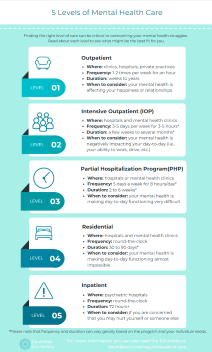One question that I often get asked by potential new clients is, “How long will it take for me/my child to get better?” To the aggravation of many, I’m sure, the answer to this question is: “It depends!” It depends greatly on what you are struggling with, how much time, energy, and effort you have available to devote to your mental health, and a host of other factors.
A crucial question that I don’t often get asked is, “Is this the right level of care for me/my child?” But what does that even mean? Let’s break it down.

Table of Contents
The Five Levels of Mental Health Care
When you are struggling with a mental health issue, it’s just as important to get the right level of care as it would be to take the right dosage of a medication prescribed by your doctor.
Too much medicine is overkill—it’s not necessarily more helpful that the right amount (and can even cause more problems!). But not enough medication means that you won’t get better the way that you would if you were taking the right amount.
Just like with medication, you want to make sure that you’re receiving not only the correct mental health treatment, but also the right “dosage.”
Generally speaking, there are 5 “levels of care” when it comes to mental health:
- Outpatient
- Intensive Outpatient Programs (IOPs)
- Partial Hospitalization Programs (PHPs, also called Day Programs)
- Residential
- Inpatient
Let’s talk about each of these.
Outpatient
Outpatient care is what you might typically think of when you think of “therapy.” It’s offered through private practices, mental health clinics, and sometimes hospitals.
How Often Do You Attend Outpatient Therapy?
Usually, outpatient therapy means that you will meet with a therapist once a week for 45 minutes to an hour.
Some types of therapy, such a couples therapy, group therapy, or trauma therapy, may meet for longer (typically up to 2 hours). And if once a week is not sufficient, you might meet with your therapist more frequently—such as two or three times a week.
As you improve, you and your therapist will usually reduce the frequency of your sessions. Over time, you may decrease to every other week, once a month, or even less often until you are ready to “graduate” from therapy.
You may find that it is helpful to have occasional “booster” sessions with your therapist even after “graduating” to stay mentally well in the long term.
How Long Does Outpatient Therapy Last?
As mentioned above, the duration of outpatient therapy varies greatly. If you have a very specific, somewhat minor issue that needs to be addressed, you may only need a few sessions. Or you may find long-term therapy helpful for maintaining your mental health over the years. Most will fall somewhere in-between and will find relief after several months.
When Should You Look into Outpatient Therapy?
If you notice that you are generally unhappy with how your life is going, you often feel sad or anxious, or you have any other mental health symptoms that are affecting your ability to enjoy your day-to-day life or your relationships, outpatient therapy may be helpful. For a full article on this topic, check out “13 Signs It’s Time to Consider Therapy.”
Intensive Outpatient Programs (IOPs)
Intensive Outpatient Programs (IOPs) are typically offered at mental health clinics or hospitals and are designed for those that need more support than typical outpatient care can provide.
How Often Do You Attend an IOP?
IOPs typically require attendance for 3 to 5 days a week, for 3 to 5 hours per day. This time may include one-on-one therapy, group therapy, psychiatric support (i.e., medication management), or other forms of support.
How Long Does an IOP Last?
IOPs are generally shorter than outpatient therapy, lasting from a few weeks to several months, but typically no longer than 6 months.
When Should You Look into an IOP?
IOPs can be helpful if your symptoms are interfering with your day-to-day life, making it difficult for you to attend work or school, maintain healthy relationships, or complete regular activities of the day (driving, showering, etc.).
Partial Hospitalization Programs (PHPs), A.K.A. Day Programs
Partial Hospitalization Programs (PHPs), often found in hospital settings, can also be referred to as “day programs” in mental health clinics. PHPs can offer the next level of support to those who need more than an IOP.
How Often Do You Attend a PHP Program?
PHPs typically run 5 days a week, for 8 hours a day—similar to a full-time job. This extended time allows you to learn and practice skills to improve your mental health. Similar to IOPs, PHPs may include one-on-one therapy, group therapy, psychiatric support (i.e., medication management), or other forms of care.
How Long Do You Attend a PHP Program?
PHPs are usually shorter than IOPs due to the higher intensity of care. Depending on the program and your needs, you may expect to attend anywhere from 2 to 6 weeks.
When Should You Look into a PHP?
If you find that you’re unable to engage in day-to-day activities, such as attending work or school, then a PHP may be beneficial. These programs offer short-term, high-intensity care for those looking to get back on track quickly.

Residential
Residential care can also be found at hospitals and some mental health clinics, although it is somewhat less common as compared to the lower levels of care.
How Often Do You Attend a Residential Program?
Residential care involves staying at a clinic or facility 24/7. While in treatment, you will eat, sleep, and take your relaxation time at the treatment facility.
Residential care typically includes one-on-one therapy, group therapy, and skill-building. Medication management from a psychiatrist is often included.
How Long Do You Attend a Residential Program?
Residential treatment can vary widely in duration, lasting anywhere from 30 to 90 days, depending on the program and your individual needs.
When Should You Look into Residential Treatment?
Residential treatment is beneficial if your mental health has deteriorated to the point where you cannot participate in your day-to-day activities, work or school.
Inpatient Care
Inpatient care is the highest level of mental health care, typically found at psychiatric hospitals or hospitals with a behavioral health unit.
Inpatient care is for individuals who are a danger to themselves or others or who are gravely disabled (i.e., physically or mentally unable to care for themselves).
Inpatient treatment may be voluntary or involuntary, depending on the circumstances.
How Often Do You Attend an Inpatient Program?
Like residential treatment, inpatient care is round-the-clock. The focus is usually on ensuring safety and providing medication management. Some inpatient programs may offer group therapy or other services, but this is not as common.
How Long Do You Attend an Inpatient Program?
The amount of time spent in inpatient care is dependent on however long it takes to ensure safety. If you are placed in inpatient care involuntarily, you may not be allowed to leave for a set period of time (in California, this is typically 72 hours, although it may be longer).
When Should You Look into Inpatient Care?
If you are having thoughts of suicide or are worried that you might hurt yourself or others, you can seek inpatient care to help keep you safe. Inpatient care is generally a temporary step before transitioning to another level of care to help you improve your mental health.
Changing Levels of Care
It is common for someone to gradually step down through different levels of care over time. For example, someone might start with a residential program, then move to an IOP, and eventually to outpatient therapy. Not everyone will need to attend every level of care, but this approach can ensure you’re getting enough support over time.
No matter your situation, it’s crucial to begin with the right level of care and move through each step as you’re ready.
For a handy cheat sheet on the different levels of care, download a PDF summary by clicking the image below:

A Practical Note
On a practical level, it must be acknowledged that cost can significantly impact the level of care available to you. Not every program will accept your insurance, and even if they do, your insurance may not cover the full cost or duration needed for substantial progress.
If you are not able to attend the level of care that you truly need due to financial or time constraints, remember that some help is better than none! I’ve witnessed truly determined clients make incredible progress by putting in the effort between sessions, even if they couldn’t attend a higher level of care.

Choosing the Right Level of Care for You
If you’re unsure about what level of care is right for you, I encourage you to reach out to a mental health provider. Our job is to help you determine what type and level of care will best serve your needs.
If you’re looking for an outpatient therapist in California to help you with your anxiety, OCD, or a related concern, feel free to contact me and I would be happy to chat! And if you’re looking for a higher level of care for OCD or a related concern, check out the Find Help section of the International OCD Foundation website for more options.
As a reminder, this blog post is not intended as professional counseling or clinical advice. This article is meant to provide you with some helpful information about the different levels of mental health care available. If you are struggling with your mental health, I encourage you to consider reaching out for additional support, professional or otherwise.

– Kristel Roper, LMFT, LPCC
Kristel Roper is a licensed psychotherapist offering therapy services to individuals in the Sacramento area. She specializes in therapy for anxiety and OCD and especially enjoys working with young women as they navigate the challenges of relationships, college, career, and beyond. If you have a question for Kristel or are interested in therapy for yourself or your loved one, feel free to reach out.
Photo by Vlada Karpovich from Pexels
Photo by Ryutaro Tsukata from Pexels
Photo by Kristopher Roller on Unsplash
